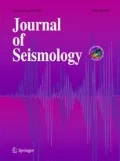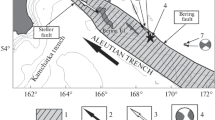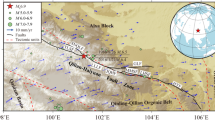Abstract
The western border of South America is one of the most important seismogenic regions in the world. In this region the most damaging earthquake ever recorded occurred. In June 23rd, 2001, another very strong earthquake (Mw = 8.1–8.2) occurred and produced death and damages in the whole southern region of Peru. This earthquake was originated by a friction process between Nazca and South American plates and affected an area of about 300 km × 120 km defined by the distribution of more than 220 aftershocks recorded by a local seismic network that operated 20 days. The epicenter of the main shock was localized in the northwestern extremity of the aftershock area, which suggests that the rupture propagated towards the SE direction. The modeling of P-wave for teleseismic distances permitted to define a focal mechanism of reverse type with NW-SE oriented nodal planes and a possible fault plane moving beneath almost horizontally in NE direction. The source time function (STF) suggests a complex process of rupture during 85 sec with 2 successive sources. The second one of greater size, and located approximately 100–120 km toward the SE direction was estimated to have a rupture velocity of about 2 km/sec on a 28°-dipping plane to the SE (N135°). A second event happened 45 sec after the first one with an epicenter 130km farther to the SE and a complex STF. This event and the second source of the main shock caused a Tsunami with waves from 7 to 8 meters that propagated almost orthogonally to the coast line, by affecting mainly the Camaná area.
Three of all the aftershocks presented magnitudes greater or equal to Mw = 6.6, two of them occurred in front of the cities of Ilo and Mollendo (June 26th and July 7th) with focal mechanisms similar to the main seismic event. The aftershock of July 5th shows a normal mechanism at a depth of 75 km, and is therefore most likely located within the subducting Nazca plate and not in the coupling. The aftershocks of June 26th (Mw = 6.6) and July 5th (Mw = 6.6) show simple short duration STF. The aftershock of July 7th (Mw = 7.5) with 27-second duration suggests a complex process of energy release with the possible occurrence of a secondary shock with lower focal depth and focal mechanism of inverse type with a great lateral component. Simple and composed focal mechanisms were elaborated for the aftershocks and all have similar characteristics to the main earthquake.
The earthquake of June 23rd caused major damages in the whole southern Peru. The damage in towns of Arequipa, Moquegua allow to consider maximum intensities from 6 to 7 (MSK79). In Alto de la Alianza and Ciudad Nueva zones from Tacna, the maximum intensity was of 7− (MSK79).
Similar content being viewed by others
References
Beck, S. and Ruff, L., 1989, Great earthquakes and subduction along the Peru trench, Phys. Earth Planet. Int. 57, 299–334.
Beck, S. and Nishenko, S., 1990, Variations in the mode of great earthquake rupture along the Central Peru subduction zone, Geophys. Res. Lett. 17, 1969–1972.
Bilek, S. and Ruff, L., 2002, Analysis of the 23 June 2001 Mw = 8.4 Peru under thrusting earthquake and its aftershock, Geophys. Res. Lett. 29, 21:1–21:4.
Boroschek, R., Comte, D. and Morales, A., 2002, Características ingenieriles del terremoto de Ocoña del 23 de Junio de 2001. In: Tavera, H. (ed), El terremoto de la región sur del Perú del 23 de Junio del 2001. Instituto Geofísico del Perú, pp. 379–388.
Borrero, J., 2002, Field survey of the June 23, 2001 earthquake and Tsunami in Southern Peru, solutions to coastal disasters 02. Proceeding edited by L. Ewing and L. Wallendorf. American Society of Civil Engineers, International Tsunami Survey Team.
Brillinger, D., Udias, A. and Bolt, B., 1980, A probability model for regional focal mechanics solutions, Bull. Seism. Soc. Am. 70, 1479–1485.
Brune, J., 1970, Tectonics stress and spectra of seismic shear waves. J. Geophys. Res. 75, 4997–5009.
Comte, D. and Pardo, M., 1991, Reappraisal of great historical earthquakes in the northern Chile and southern Peru seismic gaps. Natural Hazards 4, 23–44.
Delouis, B., Monfret, T., Dorbath, L., Pardo, M., Rivera, L. and Comte, D., 1997, The Mw = 8.0 Antofagasta (Northern Chile) earthquake of 30 July 1995: A precursor to the end of the large 1977 gap. Bull. Seism. Soc. Am. 87, 427–445.
Dengler, L., Borrero, J., Gelfenbaum, G., Jaffe, B., Okal, E., Ortiz, M. and Titov, V., 2003, Tsunami. In: Southern Peru earthquake of 23 June 2001. Reconnaissance Report. Special Supplement to Volume 9, Earthquake Spectra 115–144.
Dewey, J., Silva, W. and Tavera, H., 2003, Seismicity and Tectonics. In: Southern Peru Earthquake of 23 June 2001. Reconnaissance Report. Special Supplement to Volume 9, Earthquake Spectra, 1–9.
Dorbath, L., Cisternas, A. and Dorbath, C., 1990, Assessment of the size of large and great historical earthquake in Peru. Bull. Seism. Soc. Am. 80, 551–576.
Futerman, W., 1962, Dispersive body waves, J. Geophys. Res. 67, 5279–5291.
Giovanni, M., Beck, S. and Wagner, L., 2002, The June 23, 2001 Peru earthquake and southern Peru subduction zone, Geophys. Res. Lett. 29, 14:1–14:4.
Grange, F., Hatzfeld, D., Cunningham, P., Molnar, P., Roecker, S. and Suarez, G., 1984, Tectonics implications of the microearthquake seismicity and fault plane solutions in southern Peru, J. Geophys. Res. 89, 6139–6152.
Hansk, T. and Wyss, M., 1972, The use of body-wave spectra in the determination of seismic-source parameters, Bull. Seismol. Soc. Am. 62, 561–589.
Houston, H. and Kanamori, H., 1986, Source spectra of great earthquakes: Teleseismic constraints on rupture process and strong motion. Bull. Seism. Soc. Am. 76, 19–42.
Ihmle, P. and Ruegg, J.C., 1997, Source tomography by simulated annealing using broad band surface waves and geodetic data: applications ti the Mw = 8.1 Chile 1995 event. Geophys. J. Int. 131, 146–158.
Kanamori, H., 1977, The energy release in great earthquakes, J. Geophys. Res. 82, 2981–2987.
Keilis-Borok, V., 1959, On the estimation of the displacement in an earthquakes source and of source dimensions, Ann. Geofis. 12, 205–214.
Klein, F., 1978, Hypocenter location program Hypoinverse, U.S. Geological Survey, OpenField Report, 78–694.
Kikuchi, M. and Yamanaka, Y., 2001, Near coast of Peru earthquake (Mw = 8.2) on June 23, 2001 (revised). EIC Seismological Note: N°105, posted on the website of the University of Tokio Earthquake Information Center.
Lindo, R., Dorbath, C., Cisternas, A., Dorbath, L. and Ocola, L., 1992, Subduction geometry in central Peru from a microseismicity survey: First results. Tectonophysics, 205, 23–29.
Lindo, R., 1993, Seismotectonique des Andes du Perou Central: Apport des dones Sismologiques de Haute Precision. Thesis, University Louis Pasteur de Strabourg, Francia.
McCann, W., Nishencko, S., Sykes, L. and Krause, J., 1979, Seismic gaps and plate tectonics: Seismic potential for major boundaries. Pageoph. 117, 1082–1147.
McCaffrey, R. and Nabelek, J., 1987, Earthquakes, gravity and the origin of the Bali Basin: An example of a nascent continental fold-and-thrust belt, J. Geophys. Res. 92, 441–460.
Molnar, P. and Lyon-Caen, H., 1989, Fault plane solutions of earthquakes and active tectonics of the Tibetan Plateau and its margins, Geophys. J. Int. 99, 123–153.
Nabelek, J., 1984, Determination of Earthquake Source Parameters from Inversion of Body Waves, PhD Thesis, MIT, Cambridge, MA.
Nishenko, S., 1985, Seismic potential for large and great interplate earthquakes along the Chilean and southern Peruvian margins of South America: a quantitative reappraisal, J.Geophys. Res. 90, 3589–3615.
Nishenko, S., 1991, Circum-Pacific seismic potential: 1989–1999. Pageoph. 135, 169–259.
Ocola, L., 1979, Intensidades sísmicas del sismo. XII Congreso de Ingeniería, Universidad de Ingeniería, Lima-Perú.
Ocola, L., Shikiya, J. and Lescano, W., 1980, Intensidades del sismo del Cusco del 3 de Junio de 1980. Instituto Geofisico del Perú, 18 pp.
Ocola, L., Monge, F., Huaco, P., and Aguero, C., 1997, Severidad de Sacudimiento del sismo de Nazca de 1996. Instituto Geofisico del Perú, 22 pp.
Robinson, D. and Das, S. 2004. Rupture process of the June 23, 2001 Mw 8.4 Peru Earthquake. 2004 AGU Fall Meeting. San Francisco, EEUU.
Salden, A., Madariaga, R. and Clevede, E. 2004. Nonlinear source tomography of the Mw = 8.4, 23 June 2001 Arequipa, Peru earthquake. 2004 AGU Fall Meeting. San Francisco, EEUU.
Spence, W., Mendoza, C., Engdhal, L., Coi, L., 1998, Seismic subduction of the Nazca Ridge as show by the 1996–1997 Peru earthquakes, Pageoph. 154, 753–776.
Tavera, H. and Bernal, I., 2005, Distributión especial de áreas de ruptura y lagunas sísmicas en el borde oeste del Perú. Volumen Jubilar N°6 Homenaje a Alberto Giesecke Matto, Sociedad Geológica del Perú 89–102.
Tavera, H., Buforn, E., Bernal, I. and Antayhua, Y., 2002, The Arequipa (Peru) earthquake of June 23, 2001, Journal of Seismology, 6, 279–283.
Tavera, H. and Buforn, E., 2001, Source mechanisms of earthquakes in Peru. Journal of Seismology 5, 519–539.
Tavera, H., Buforn, E. and Perez-Pacheco, I., 1998, Mecanismo focal del terremoto de Nazca (Perú) del 12 de Noviembre de 1996 (Mw = 7.7). Revista Geofisica, Instituto Panamericano de Geografia e Historia, N°49, 143–163.
Taymaz, T., Eyidogan, H. and Jackson, J., 1991, Source parameters of large earthquakes in the East Anatolian fault Zone (Turkey). Geophys, J. Int. 106, 537–550.
Author information
Authors and Affiliations
Corresponding author
Rights and permissions
About this article
Cite this article
Tavera, H., Fernández, E., Bernal, I. et al. The Southern Region of Peru Earthquake of June 23rd, 2001. J Seismol 10, 171–195 (2006). https://doi.org/10.1007/s10950-006-9014-2
Received:
Accepted:
Published:
Issue Date:
DOI: https://doi.org/10.1007/s10950-006-9014-2




